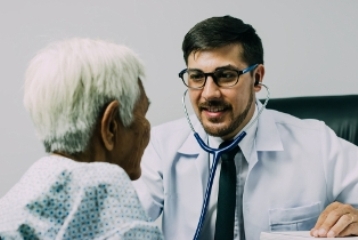The COPD National Action Plan and its Impact on Patients in Rural America
Posted on April 19, 2018 |
By Bret Denning, COPD Foundation Care Delivery and Communications Program Specialist
Several COPD Foundation staff members attended a workshop on how the COPD National Action Plan can be used to advocate for better treatment options in rural America. Here is one analysis of the workshop and the common themes that emerged from the day.
I attended a workshop at the National Heart, Blood and Lung Institute (NHLBI), COPD & Rural Health: A Dialogue on the National Action Plan. It was a fascinating conversation on how the different components of the COPD National Action Plan can be transformed from theory into actual practice in rural America.

The workshop began with some sobering facts about COPD in rural America and the unique challenges facing residents of those areas. According to the Centers for Disease Control, COPD rates are significantly higher in rural areas (8.2%) than in urban settings (4.7%). For the most part, residents of rural communities tend to be less educated and more likely to smoke, two traits commonly associated with higher levels of COPD. Access to care is a constant challenge for rural communities and this makes it harder for individuals to be diagnosed with COPD and, perhaps more importantly, to receive the treatment they need to manage their condition.
The program featured a discussion of each component of the COPD National Action Plan with presentation by leading experts in the field. What made this workshop so unique and impactful was the interactive nature of the program. The presentations were meant to facilitate discussion among attendees so they could share experiences and examples of what they are doing in their own communities.
Throughout the day, I noticed several themes emerging from the conversation and rather than discussing each component of the action plan, I want to focus on the topics that participants kept raising based on their own experiences as either a patient or healthcare provider. The themes that I continued to hear throughout the day were:
- Access to information and the ability to trust the people providing that information;
- The need for more treatment and other resources; and
- Proper reimbursements for treatment.
1. Information and Trust
During the conference, the importance of getting more information to residents of rural areas was often raised. In connection, speakers also stressed that the information must come from a resource that people trust. Several people mentioned the church as a vital part of community life in rural America and how churches could be recruited as partners to disseminate information about COPD to the community. Additionally, houses of worship can be a resource for community information sessions where medical professionals can make presentations directly to the residents of the community.
The issue of trust also came up while discussing the prospect of telemedicine. Clearly, telehealth has many benefits and the potential to reach people in remote locations, but there is still the challenge of developing a relationship with the patient so they feel confident about their care and treatment.
What can you do to help build that level of trust between patients and their healthcare providers? Can the relationships you have developed in your community lead to stronger relationships with specialists?
The COPD Foundation has an extensive library of helpful materials that providers can order and share with patients to help them learn about COPD and how they can work together on managing the disease. These materials could also prove to be helpful resources if you chose to make community presentations about COPD and what people can do if they have questions.
Another way to build trust is through shared decision-making. The My COPD Action Plan is designed to support this approach, by encouraging healthcare providers and patients to work collaboratively toward a symptom management plan. The My COPD Action Plan can be found here.
2. Access to care
Perhaps the most commonly discussed topic at the workshop was how difficult it was for people with COPD to find necessary care and other resources, such as support groups, in their communities. Participants shared stories of patients having to travel more than 100 miles just to meet with a pulmonologist. Many people are not able to travel such a long distance on a regular basis and this impedes their ability to receive adequate treatment. While some participants suggested advocating for travel reimbursements, it was noted that studies have shown that many people are unwilling to travel more than 35 miles, even with reimbursements.
The need for more pulmonary rehabilitation centers was frequently raised during the day. Pulmonary rehab is an extraordinarily valuable resource for COPD patients and access to rehab programs is often a challenge for rural Americans. One participant at the conference used his parents as an example: his mother had COPD and in order to participate in 12 weeks of pulmonary rehab, his father drove her more than 4,900 miles during that time. Speakers also noted that when new pulmonary rehab programs are started, they are almost immediately filled, clearly showing that demand for these programs in some areas greatly exceeds current capacity. The COPD Foundation has prioritized increasing access to pulmonary rehabilitation as one of our top policy goals and we hope that by working with policy makers, health officials and communities in rural areas, we can find new ways to support the expansion of pulmonary rehabilitation programs.

In addition to limited access to care, many panelists stated that patients in remote locations are restricted in their access to support systems such as in-person support groups. Some of the patients at the workshop noted that they used online networking sites, such as the COPD Foundation’s COPD360social platform as a means of support; however, they also stated that it was not the same as being in the same room as people experiencing similar issues. It should be noted that pulmonary rehabilitation programs also serve as a support group for many participants.
Similarly, how could you help patients find a support group? The COPD Foundation provides the online COPD360social community. If you are interested in starting a support group in your community, inexpensive leader kits can be purchased here.
3. Cost of Care

Many people noted that even when patients did have access to pulmonary rehab, the reimbursement rate did not come close to matching the cost of treatment. A suggested goal for moving forward was to continue advocating for higher reimbursement rates, similar to the rates provided for cardiac rehabilitation. It was stated several times that a $200 expense reimbursed at $100 is not a sustainable program. This topic seemed to raise the most frustration among speakers and attendees. It greatly limits the number of patients who can receive care and the problem exists among all payors, from private insurance to government programs. Participants also noted that out-of-pocket costs are a particular barrier for pulmonary rehabilitation and for other types of important treatments like inhalers and oxygen.
There are many ways for healthcare providers to participate in advocacy efforts, such as joining the COPD Foundation’s State Captains Program. State Captains serve a variety of functions, including advocating for policy changes at the local, state and federal level. If you want more information on becoming a State Captain, contact our team at statecaptains@copdfoundation.org.
You can also visit the COPD Action Center to receive policy alerts and updates. You can also search for your representatives in Congress in the Action Center. Finally, the COPD Foundation recently introduced the Advocacy Ambassador Program, which provides training on how to contact and meet with your elected officials. Contact Tracie Sullivan for more information on that as well.
Conclusion
This workshop was a valuable step in the process of bringing the goals and ideals of the COPD National Action Plan to rural America. The conference also served to illustrate how much work has to be done. The disparity in care between individuals with COPD living in rural vs. urban environments is tremendous and it will take time to close that gap. Moving forward, it is imperative to have all stakeholders engaged to achieve common goals and to develop strategies to address the burden of COPD in rural America.
The COPD Foundation is committed to helping healthcare providers address the many challenges of treating patients with COPD in rural communities. Our website provides a wealth of information for patients, caregivers and healthcare providers.
This page was reviewed on March 3, 2020 by the COPD Foundation Content Review and Evaluation Committee